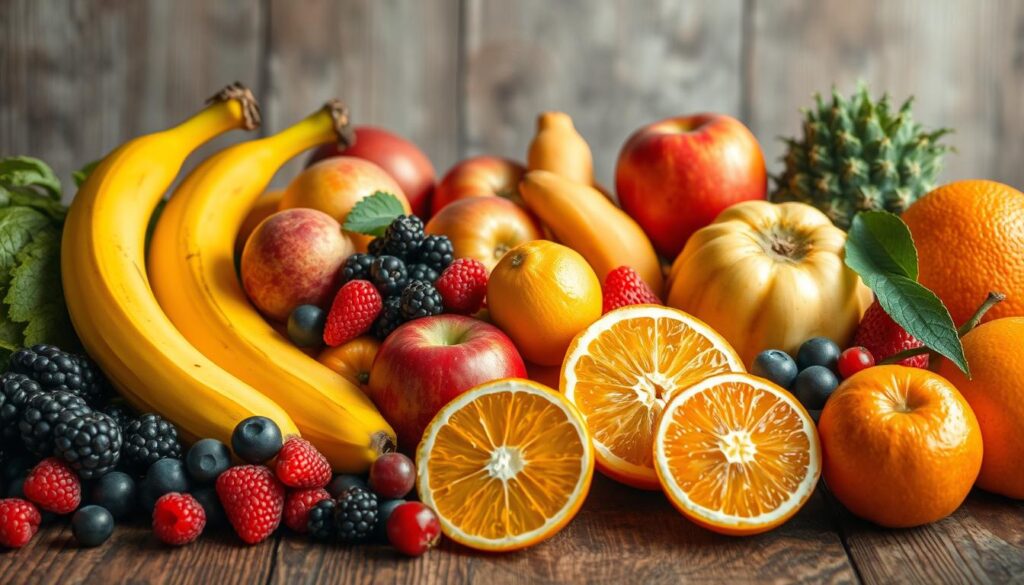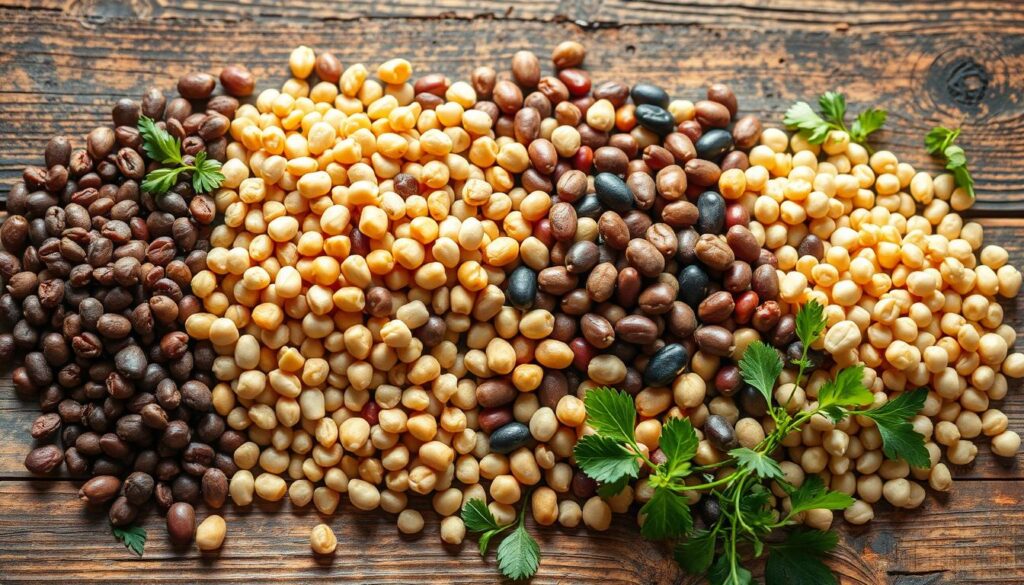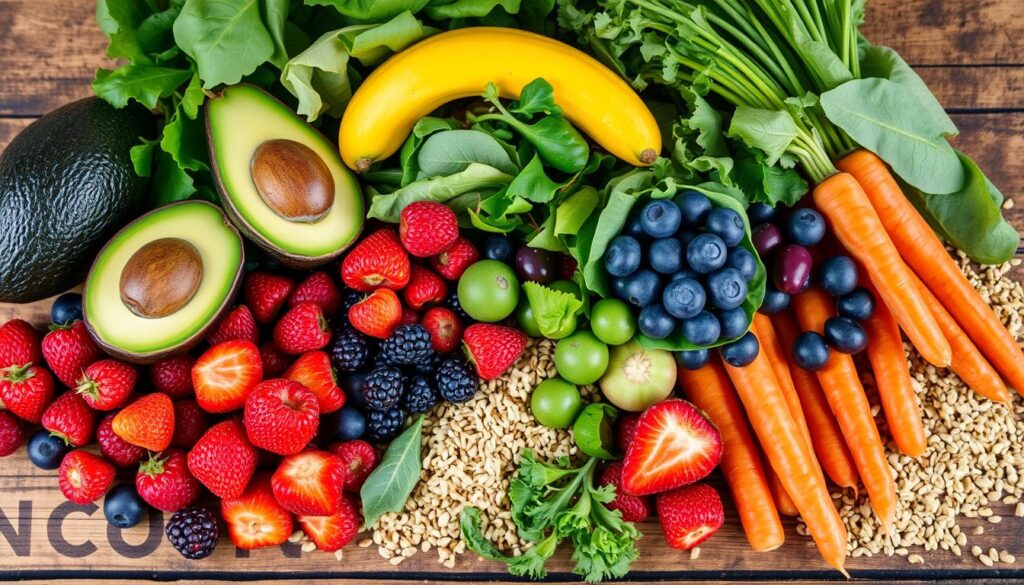Hemorrhoids are common, affecting up to 1 in 20 Americans. They can make life hard. But, eating more fiber can help a lot. The 2015-2020 Dietary Guidelines say we should eat 14 grams of fiber for every 1,000 calories. Most of us don’t get that much.
By eating more fiber, you can help your gut health. This can also help with hemorrhoids. It’s a natural way to feel better.
Key Takeaways
- Fiber-rich foods can help relieve hemorrhoid symptoms by increasing stool weight, softening stools, and decreasing colon transit time.
- Aim for 25-30 grams of fiber per day, with at least one-third being soluble fiber.
- Whole grains, fruits, vegetables, legumes, and nuts are excellent sources of fiber for hemorrhoid management.
- Avoid low-fiber foods that can worsen constipation and hemorrhoids, such as white bread, processed foods, and sugary baked goods.
- Consult a healthcare professional if increasing fiber intake does not provide relief or causes discomfort, as alternative approaches may be necessary.
Understanding Hemorrhoids and Their Impact on Daily Life
Hemorrhoids affect millions and can really mess up your day. These swollen veins in your anus and lower rectum cause pain and discomfort. Simple tasks become hard.
Types of Hemorrhoids and Common Symptoms
Hemorrhoids come in two types: internal and external. Internal hemorrhoids are inside the rectum. They cause bright-red bleeding and a feeling of fullness. Sometimes, they even come out.
External hemorrhoids are under the skin around the anus. They cause itching, swelling, and painful blood clots.
How Diet Affects Hemorrhoid Symptoms
Your diet is key in managing hemorrhoid symptoms. Eating a high-fiber diet helps keep bowel movements soft. This reduces strain and pressure on your rectum.
Eating more fiber-rich foods can soften stools. This helps prevent constipation, a common cause of hemorrhoid flare-ups.
The Role of Fiber in Hemorrhoid Management
Fiber is vital in managing hemorrhoids. It makes stools soft, making them easier to pass. This reduces strain on the rectal area.
This helps lessen symptoms like pain, swelling, and bleeding.
“Maintaining a diet rich in fiber is one of the most effective ways to manage hemorrhoid symptoms and prevent future flare-ups.”
Knowing about hemorrhoids, their symptoms, and diet’s role helps. You can take steps to improve your life and find relief.
High Fiber Food for Hemorrhoids: Essential Dietary Changes
Do you have hemorrhoids? Your diet might help. Eating more high-fiber foods can really help. Fiber can cut down on bleeding from hemorrhoids by up to 50%.
Fiber comes in two types: soluble and insoluble. Soluble fiber is in oat bran, beans, and some fruits. It makes a gel that slows digestion. Insoluble fiber is in wheat bran and veggies. It makes your stool bulkier, helping it move better.
To get the most from fiber, add it slowly to your diet. This helps avoid gas or bloating. Try to eat about 28 grams of fiber a day for a 2,000-calorie diet. This helps with hemorrhoid symptoms and keeps your digestive system healthy.
| High Fiber Foods for Hemorrhoid Relief | Fiber Content (per serving) |
|---|---|
| Lentils | 15.6 grams |
| Raspberries | 8 grams |
| Broccoli | 5.1 grams |
| Oats | 4 grams |
| Spinach | 4.3 grams |
Eating more high-fiber foods is a big step towards better hemorrhoid management. It also boosts your digestive health. A fiber-rich diet fights constipation and its discomfort.
Powerful Whole Grains for Hemorrhoid Relief
Adding fiber-rich whole grains to your diet helps with hemorrhoids. Grains like wheat bran, shredded wheat, barley, and oats are great. They help your gut and offer relief.
Wheat Bran and Shredded Wheat Benefits
Wheat bran is full of fiber, with 9.1-14.3 grams in a small amount. Shredded wheat cereal has 5-9 grams of fiber in a cup. These grains make stools softer, easing hemorrhoid pain.
Barley and Oats for Digestive Health
Barley is packed with fiber, including β-glucan. This fiber makes stools softer and improves digestion. Oatmeal also boosts gut health with 4 grams of fiber per cup.
Whole Wheat Products and Their Advantages
Whole wheat bread, pasta, and cereals are better than refined ones. They keep the whole grain, including bran and germ. Eating these can greatly help with hemorrhoid symptoms.
Eating whole grains and staying hydrated helps with hemorrhoids. Simple changes in your diet can improve your health and ease discomfort.
Fruits That Help Manage Hemorrhoid Symptoms
Fruits are very helpful for managing hemorrhoid symptoms. They are full of fiber and water. This helps your digestive health a lot.
Prunes are a great fruit for this. They have 3.8 grams of fiber in just half a cup. This helps with bowel movements and reduces straining.
Apples with their skin are also good. They have 4.4 grams of fiber per fruit. Pears with their skin have 6 grams of fiber.
Berries, like raspberries, are very fiber-rich. They have 6.5 grams of fiber per 100-gram serving. This is because they have a lot of skin.
Citrus fruits and kiwis are also good. They are not just fiber-rich. They also help with constipation, which is common with hemorrhoids.
Adding these fruits to your diet is a smart move. It helps manage hemorrhoid symptoms and improves your digestive health.

“Fiber is the foundation of a healthy hemorrhoid diet. By incorporating a variety of fiber-rich fruits, you can find natural relief and support your digestive system.”
Beneficial Vegetables for Hemorrhoid Treatment
Vegetables are key in a diet for managing hemorrhoids. They are full of fiber, which helps with bowel movements. This can reduce inflammation and improve gut health, helping to fight hemorrhoid discomfort.
Leafy Greens and Their Fiber Content
Leafy greens like spinach and Swiss chard are packed with fiber. Spinach has 2.4 grams per cup, and Swiss chard has 4.3 grams. These veggies make stools bulkier, easing waste passage and reducing strain on hemorrhoids.
Root Vegetables for Digestive Health
Root veggies like sweet potatoes and potatoes are good for hemorrhoid sufferers. A medium sweet potato has 3.8 grams of fiber. A regular baked potato has 3.6 grams. These starchy, fiber-rich foods aid digestion and cut down inflammation.
Cruciferous Vegetables Benefits
Broccoli, a cruciferous veggie, has 5.1 grams of fiber per cup. It also has sulforaphane, which boosts digestion and fights inflammation. Artichokes, another cruciferous veggie, have 10.3 grams of fiber per medium-sized one.
Eating a mix of these fiber-rich, anti-inflammatory, and gut-friendly veggies is smart. It helps nourish your body and aids in better digestive health and comfort.
Legumes and Pulses: Your Fiber-Rich Allies
Legumes and pulses are great for managing hemorrhoids. They are full of dietary fiber. This helps your digestive health a lot. Adding these fiber food for hemorrhoids to your diet can really help.
Lentils have 15.6 grams of fiber per cup. Navy beans have 9.6 grams per half-cup. Kidney beans have 5.7 grams per half-cup. Chickpeas, lima beans, and split peas are also good for fiber.
These foods are not just good for fiber. They also have protein, minerals, and antioxidants. These help your digestion and overall health. Eating these foods regularly can help manage hemorrhoid symptoms and improve constipation relief.
| Food Item | Fiber Content (per serving) |
|---|---|
| Lentils (cooked, 1 cup) | 15.6 grams |
| Navy Beans (cooked, 1/2 cup) | 9.6 grams |
| Kidney Beans (cooked, 1/2 cup) | 5.7 grams |
| Chickpeas (cooked, 1/2 cup) | 6.2 grams |
| Lima Beans (cooked, 1/2 cup) | 6.6 grams |
| Split Peas (cooked, 1/2 cup) | 8.1 grams |
Legumes and pulses are key to managing hemorrhoids. They are full of fiber. Adding them to your diet can help a lot.

Smart Snacking Options for Hemorrhoid Relief
Snacking can help when you have hemorrhoids. Choose foods high in fiber instead of processed snacks. This can help ease your symptoms. Adding these snacks to your high fiber diet can help manage your hemorrhoid remedies naturally.
Nuts and Seeds Choices
Nuts and seeds are full of fiber, making them great for snacks. Try almonds, pistachios, walnuts, or sunflower seeds. They help with bowel movements and are tasty and filling.
Healthy Alternatives to Processed Snacks
Don’t eat chips or candies. They can make constipation and hemorrhoid symptoms worse. Instead, eat whole grain crackers, fresh fruits, or raw veggies. These foods are rich in fiber and help your digestive system.
| Snack Option | Fiber Content |
|---|---|
| Almonds (1 oz) | 3.5 grams |
| Raspberries (1 cup) | 8 grams |
| Whole Wheat Crackers (3 crackers) | 2 grams |
| Apple (1 medium) | 4.5 grams |
| Carrot Sticks (1 cup) | 3 grams |
Adding these fiber-rich snacks to your day can help with hemorrhoid symptoms. A high fiber diet is important for lasting relief from hemorrhoids.
Foods to Avoid When Managing Hemorrhoids
Eating a diet rich in fiber is key to managing hemorrhoids. But, some foods can make symptoms worse. Knowing which foods to avoid can help you feel better and keep your gut healthy.
Stay away from processed and fried foods. They have little fiber and lots of bad fats. This can cause constipation and make you uncomfortable.
Foods low in fiber can also be a problem. This includes fruits, veggies, whole grains, and legumes. Eating more of these can help you go to the bathroom regularly and ease symptoms.
Drinking too much alcohol is not good either. It can make you dehydrated and affect your bowel movements. Caffeine in coffee can also make stools harder and hurt more.
Try to eat less red meat, organ meat, and processed meats. They have little fiber and can slow digestion. This can make constipation and hemorrhoid symptoms worse.
By choosing the right foods, you can manage your hemorrhoid symptoms better. This helps your gut stay healthy too.
Implementing a High-Fiber Diet: Tips and Strategies
Adding high-fiber foods to your diet helps with hemorrhoids. But, start slowly to avoid stomach upset. Aim for 25 to 30 grams of fiber daily. Most people only get about 15 grams.
For a smooth transition, aim for 14 grams of fiber per 1,000 calories. This helps your body adjust. Mix different fiber-rich foods in your meals and snacks. For example, add berries to oatmeal or mix veggies in salads.
Reading nutrition labels helps find high-fiber foods easily. If diet changes aren’t enough, think about fiber supplements. But, talk to your doctor first to find the right one for you. With the right plan, high-fiber foods can help with hemorrhoids and improve digestion.


A Life-Changing Experience with This Weight Loss Supplement (Nagano Tonic)
I’ve always struggled with finding a weight loss solution that actually works for me. Like many, I’ve tried numerous diets, exercise routines, and supplements over the years—some worked for a short time, but nothing ever gave me long-term results. That was until I decided to try the weight loss supplement I found : Link to the Supplement.
From the moment I started using it, I noticed a difference. Not only did I feel more energized, but my cravings also became more manageable. The best part? I started seeing results much quicker than I anticipated! Over the course of just a few weeks, I noticed a significant reduction in belly fat and overall weight loss that I hadn’t been able to achieve before.
What makes this supplement stand out from all the others I’ve tried is how it supports me in my daily routine without any jitters or energy crashes. I’m able to stay focused and motivated, which has made it easier to stay on track with my diet and exercise plan.
This product truly exceeded my expectations, and I feel more confident and healthier than ever before. If you’re struggling with your weight loss journey like I was, I highly recommend giving this supplement a try. It’s been a game-changer for me, and I’m sure it can work wonders for you too!
Contant Them on email .. tonicnagano50@gmail.com
I’ve tried so many weight loss products over the years, but nothing worked like this supplement! Since I started using it, I’ve noticed a big difference in my energy levels and appetite control. In just a few weeks, I’ve lost weight and feel so much better. It’s been easy to stick with, and the results speak for themselves. Highly recommend this to anyone looking to make a real change!
wasn’t sure what to expect, but this weight loss supplement has really impressed me! After just a few weeks of use, I’ve already dropped a few pounds and feel more motivated to stay active. It’s helped curb my cravings and boosted my energy throughout the day. I’m excited to keep going and see even better results. Definitely worth trying!
Reach them on tonicnagano50@gmail.com
I was skeptical at first, but this supplement has truly made a difference in my weight loss journey. I’ve lost weight without feeling deprived or sluggish. My cravings are under control, and I feel more confident in my body. It’s easy to incorporate into my daily routine, and the results speak for themselves. I’m so glad I gave it a try!
Thanks David, i do use the link to make my purchase. you can get too here http://surl.li/iasppy
I’ve tried so many weight loss products, but this one has been by far the most effective. In just a few weeks, I’ve noticed a visible difference in my body and energy levels. It’s helped me stay on track without the constant hunger pangs and cravings. I’m really happy with my progress and can’t wait to see where I’ll be in another month!
This Nagano Tonic has been amazing! In just a few weeks, I’ve lost weight, feel more energized, and my cravings are under control. Highly recommend it!
Thats the link to purchase http://surl.li/iasppy